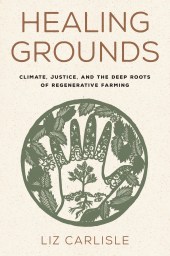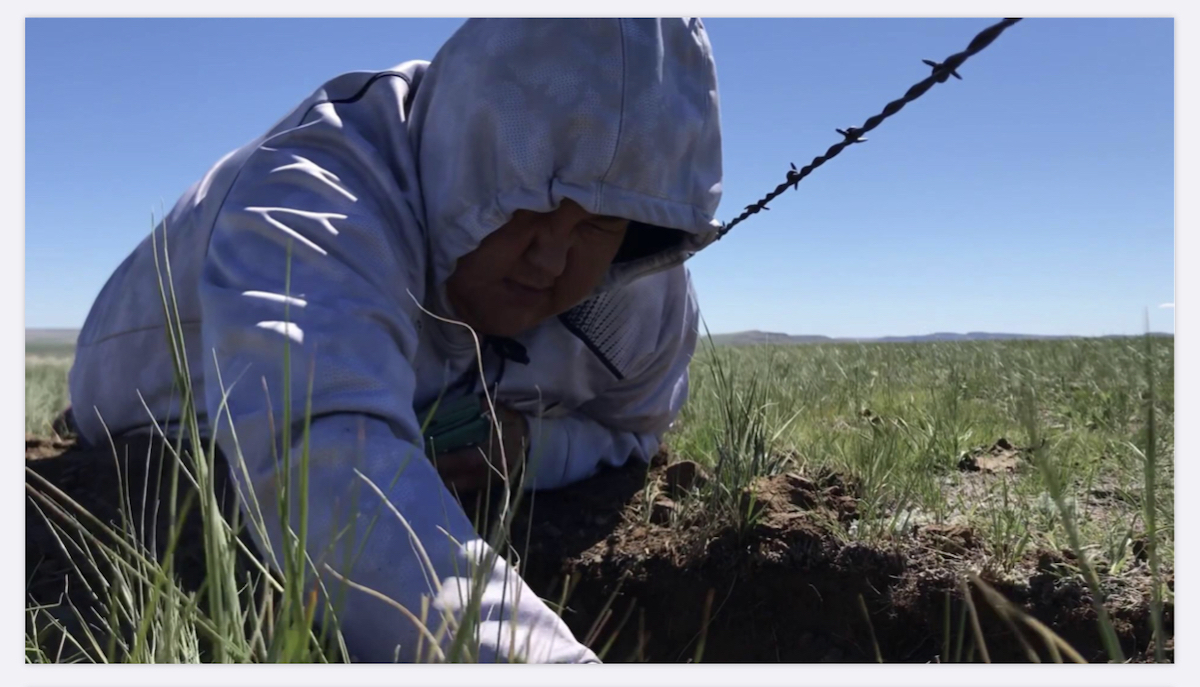UCSB Professor Writes About Saving Soils and Restoring Rights
Liz Carlisle’s “Healing Grounds” pairs regenerative agriculture with racial justice.
By Matt Kettmann | May 5, 2022

If you’re waiting in Dr. Woke’s office for your latest dose of progressivism — a recyclable syringe loaded with antigens to fight colonialism, uplift the oppressed, and conquer climate change — you’ll probably find a copy of Healing Grounds: Climate, Justice, and the Deep Roots of Regenerative Farming in the lobby.
The new book by Liz Carlisle, who’s an associate professor of environmental studies at UCSB, is a deeply researched, intellectually inspiring narrative about how Indigenous people and communities of color are using — and have always used — farming techniques that work with, rather than against, the land to survive when all odds were stacked against them. With chapters focused on a Blackfoot woman in Montana, Black women in North Carolina, and Mexican and Asian immigrant families in California, Carlisle details with hard evidence and earnest emotions how much there is to learn from these communities, and why shifting toward their ways may be a key to saving us all.

“The extraction of carbon from soils was just one integral piece of a much larger process of extraction, a process that included the theft of indigenous lands, the forced enslavement of millions of Africans, and the extortion of immigrant labor,” she writes as a thesis of sorts, tucked quietly toward the end of the 177-page book. “To repair the soil, we needed to repair it all.”
I first wrote about Carlisle in last year’s Earth Day issue, when I learned that the Missoula, Montana, native grew up listening to her grandmother’s heartwarming yet ultimately tragic memories of surviving the Dust Bowl. While touring as a country singer after graduating Harvard, Carlisle heard more tales of mismanaged farmlands and started working for Montana’s Senator Jon Tester, an organic farming proponent. Grad school at Berkeley was followed by four years at Stanford and two co-authored books — Lentil Underground and Grain by Grain — before she landed at UCSB in 2019.
About a dozen years ago, Carlisle became fascinated with regenerative agriculture, which uses time-tested farming techniques that trap carbon in the soil, thereby reducing the emissions that cause climate change. It’s gone mainstream in recent years, thanks to documentaries like Kiss the Ground and The Biggest Little Farm, and even General Mills is producing cereal with regenerative ag certification. That popularity pushed Carlisle deeper into telling true stories of real people working in regenerative ways, and she found a special resonance with racial justice by connecting with farmers of color across the country.
“They have been developing regenerative agriculture for a long time as strategies of resistance and survival,” she explained to me last month. “They were really getting to the root cause of why we have climate problems in agriculture, and how to shift from an extractive relationship with the land to a reciprocal relationship with the land. I wanted to present that vision and that deep, deep history within Indigenous communities and communities of color. Here is the real climate solution. We need to take leadership from these folks if we want to change.”

Latrice Tatsey
The Ellwood resident tells us more about her book below, and our conversation has been edited for clarity and length.
How did you decide which farmers to include? That’s a challenge with narrative nonfiction: finding individual characters to stand in for a complex, heterogeneous community. There’s a lot of people doing really amazing work in regenerative agriculture.
There were a lot of ethical considerations, being that I am a white woman. I wanted to speak with people who knew me well enough that they felt comfortable to tell me, “That’s not the right way to say that.”
It was important that people had their own platform. I don’t want anyone to read my words as a definitive account. All of these people tell their own stories and speak for themselves.
But this is clearly from my perspective, so the first story takes place in Montana, where I’m from; the last two are in California, where I’ve lived and worked the past dozen years; and the second story is from North Carolina, where my partner is from.
You are fighting for small farms, but don’t we still need those huge farms to feed the world? When I think about the food security question, what really stands out to me is the extraordinary wastefulness of the industrial system that we have. One of the opportunities of these regenerative systems is that they are more regional and based on more of a food sovereignty principle. People are involved at all stages of the process of growing and processing and delivering food to the table. These systems are a lot less wasteful because, from the very beginning of the process, they’re designed with the community and its needs in mind.
The industrial, export-oriented food system that we have — which is really visible in the Central Valley of California and the Midwestern part of the U.S. — is not driven by some sense of the end-user needs. It’s driven by manufacturing a financial commodity for trading on the global market. That system doesn’t incentivize reducing waste. Something like 40 percent of food is flat-out wasted somewhere along the supply chain, so all that energy that goes into it is just wasted.
That’s mostly locked in place for economic reasons. I’m interested in highlighting those reasons while uplifting visions for alternate ways that we can better meet human food needs while also taking better care of the land and creating a more equitable economy. There’s a lot of synergy there. We’re going to need to support that process by creating more and more democratized control over that food system and what we want it to produce for us.
Are things moving in the right direction? A lot of the current industrial corporate powers in the food system see ways to incorporate techniques like no till farming and maybe some degree of cover cropping without fundamentally challenging their business model. Those are good steps to take. They’re going to have some benefits, in the short term. They’re going to help with providing more resilience for droughts, and they might make a minimum impact on the atmosphere and waterways.
So if we want to just have regenerative agriculture that will be a small piece of the climate puzzle and help a little bit with resiliency, then you can get away with keeping the structure of the food system as it is. But that’s not only a missed opportunity from a climate perspective; it’s a missed opportunity to address racial justice in the food system.
It’s not healthy to have four firms controlling virtually every segment of the system. It’s harder to change policies that challenge power and shift who controls the land and the markets, but that’s what we need to do if we really want regenerative agriculture to function as a climate change solution that tackles 25 to 30 percent of human-caused emissions.
Who’s the audience for this book? You never know as an author. First and foremost, it was for my students at UCSB. There aren’t enough texts that represent leadership from people in communities of color in the field of sustainable agriculture, and that’s been called out quite a bit.
I’ve had a lot of my students say that they can’t imagine going into agriculture in any shape or form because they never have seen a representation of someone who looks like them being a leader. Anytime I would show photographs of diverse leaders in sustainable agriculture, students would come up and say, “That was impactful.” I wanted to take that a step further with this narrative book.
I was also thinking about all of us who eat and want those meals to be nourishing, and want to be part of the solution, to live our lives in this way that’s working toward climate solutions. I hope it helps people as they think about what kind of food system to support as an eater and a citizen who votes and gets active.
Are you optimistic? I’m not an optimist, in that I don’t think things are going to go in a good direction by default. But I’m not a pessimist who thinks they are gonna go in a bad direction by default. We as a society have an opportunity to act, and it’s a really exciting time to be alive. Even though it’s a really intense time, especially for vulnerable communities.
There are so many ways for young people to plug in, to take action that they can see in a tangible way. Getting involved in a community garden is the ultimate example of that: providing food directly to communities, seeing plants grow and areas restored back to life. You can see and touch and approach that. And you can imagine that, if this is happening in neighborhoods all over the country, we’re helping to balance the world.
A lot of my students have experienced the world as isolating, with very little community, with all of important stuff locked up and closed off. The beautiful thing about working on a community garden or farm is that you start to build something really beautiful and valuable that’s nourishing and shared. That builds awareness that it’s possible that we don’t have to be a world of haves and have nots, of people who are secure and people who are vulnerable — that, in fact, we can create a shared, happy reality.

Latrice Tatsey digs a soil pit for her research on the carbon sequestration benefits of buffalo grazing at Blackfeet Nation in Montana.| Courtesy of Latrice Tatsey
Support the Santa Barbara Independent through a long-term or a single contribution.




You must be logged in to post a comment.